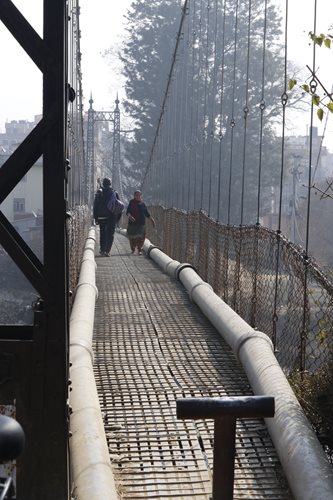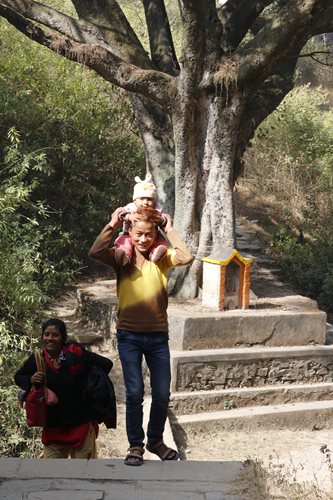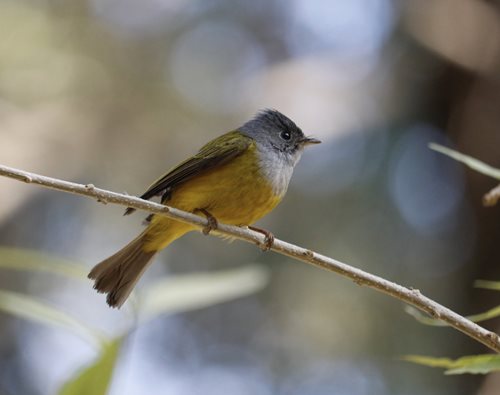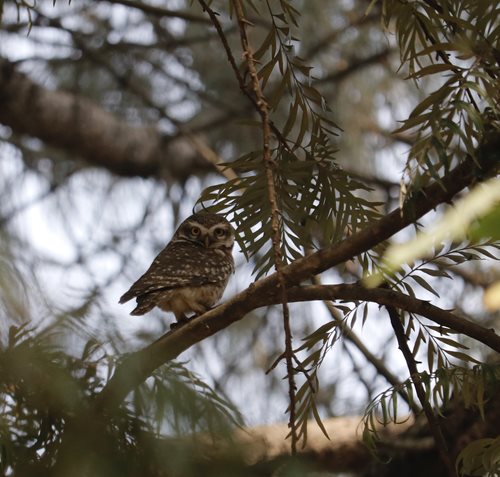I live in what used to be called the Nepal Valley – the 28km-wide basin that contains at least four ancient kingdoms. There’s Kathmandu, then across the holy Bagmati River is Patan, which these days is contiguous with Kathmandu. Both kings were Hindu. Then 16km east is the Malla (Buddhist) capital of Baktapur, which like the two Hindu capitals has its own Durbar (royal) square. Other settlements boasting fine architecture and superb temples especially Kiritpur and Thimi in particular also claim once to have been kingdoms and the Valley is dotted with place names ending in kot – meaning fortified town. The Valley wasn’t always a tranquil place.
Around the now settled cities towns and villages there is still room ricefields, and temples are still surrounded by forests so that outside the Kathmandu/Patan ring road can still feel quite rural.
On Sunday S and I pedalled west, took our lives in our hands to negotiate the traffic chaos to cross the ringroad and continued on our bicycles until we registered the characteristic and unappetising wafts of the holy Bagmati River.
At the beginning of the twentieth century hereditary prime minister …. Chandra Shamsher Jang Bahadur Rana (aka Chandra SSJB Rana) made a visit to the UK and was impressed enough with British Engineering to buy some dozen steel suspension bridges and had them shipped out from Aberdeen. They were all erected around 1903 (there's more about these at
Harper Bridges). They were only ever intended for pedestrians and wobble and bounce quite a bit as we discovered when we cycled across one en route for our destination, Chobhar. This allowed us to do some of the seven kilometre route off road.
At the bottom of Chobhar Hill we abandoned the bicycles and started up the stone steps to the Adinath temple. Some of stone steps were decorated with carved lotus flowers and several with figures suggesting perhaps that the faithful should be prostrating themselves as they climbed. There were little shines at regular intervals, places for butter lamps to light the way, and half way up a vast pipal / peepul tree over-saw a lovely shady spot where we sat that listen to the sounds of the forest. The tree itself had threads encircling its trunk which I’ve been told is from the clothes of ill people – a sacred request for the return to health.
A pair of black kites were wheeling and flying in perfect synchrony close to their new nest, and at one point locked claws and tumbled spinning together downwards only to swoop up again to continue their courtship. It was such a rich spot for birdlife. There were barbets, bulbuls, drongos, parakeets, magpie robins and a host of difficult-to-identify small twittering finches and warblers. Then a startlingly yellow hyperactive flycatcher came close, and through making hunting forays and returning to the same perch, I managed to photograph it, and put a name to it: the grey-headed canary-flycatcher.
A little further up we paused to watch goats snaffling rice offerings from a shrine. Than an unfamiliar call shifted my attention back to the trees. I clocked movement in one of the massive pines and eventually managed to focus on two huge eyes and an endearing bundle of grey and white feathers.
And here we were only part way through our outing. There were yet more delights in store when we reached the temple.
 |
| Footbridge over the Bagmati River at Sundari built in Aberdeen and erected around 1903; the T-piece is to stop motocyclists driving across |
 |
| Plaque on the footbridge at Sundari - erected around 1903 and still in use |
 |
| Lotus and prostrated pilgrims on the steps leading to Chobhar |
 |
| Family walking past the huge pipal tree on their way to Chobhar |
 |
| Goat snaffling rice offerings on Chobhar Hill |
 |
| The hyperactive grey-headed canary-flycatcher |
 |
| Spotted owlet |